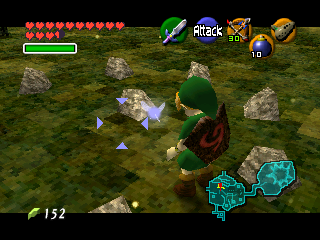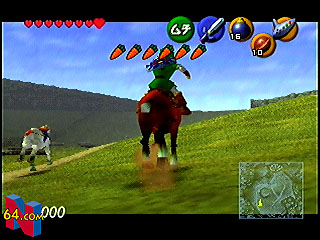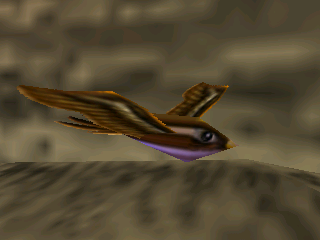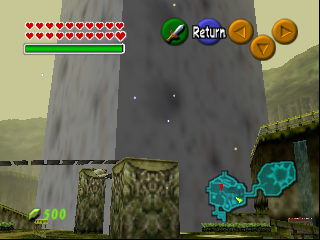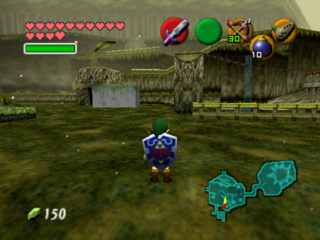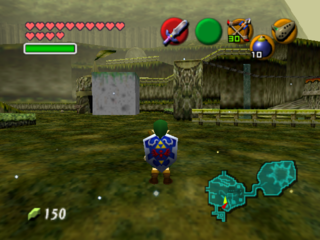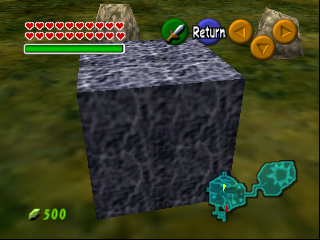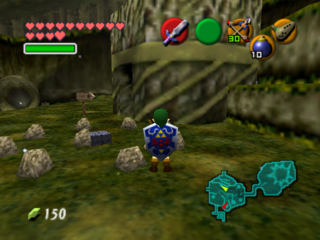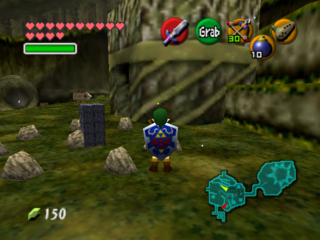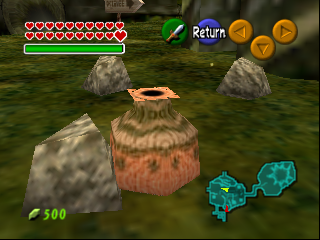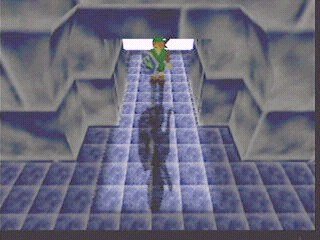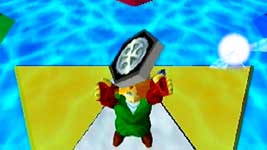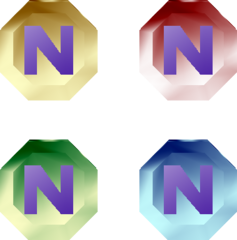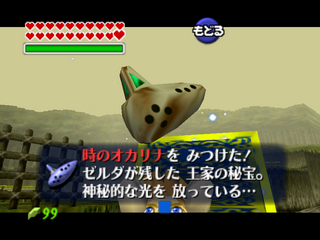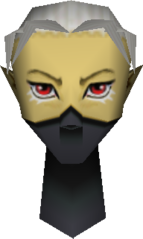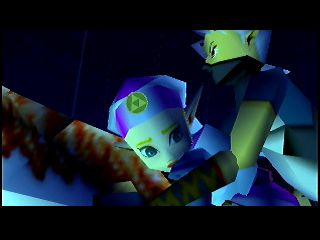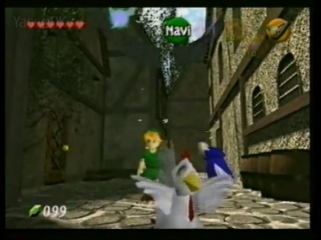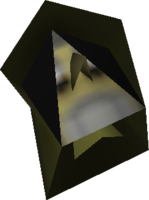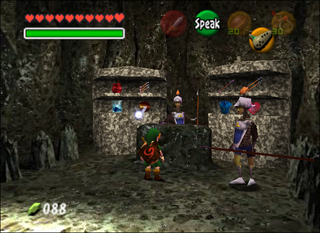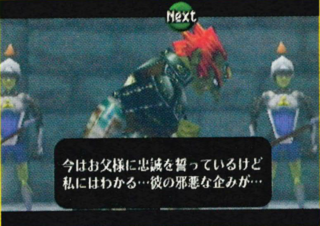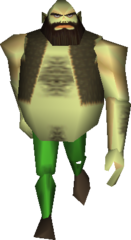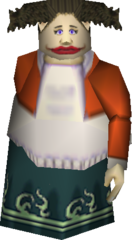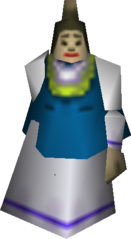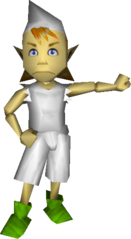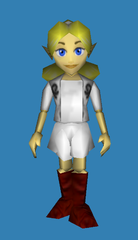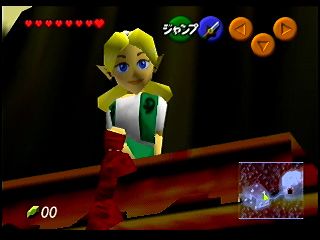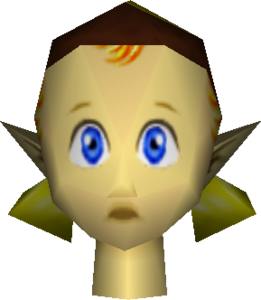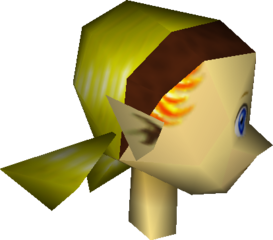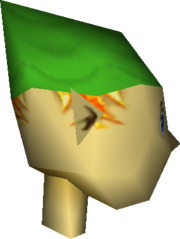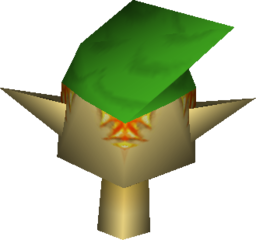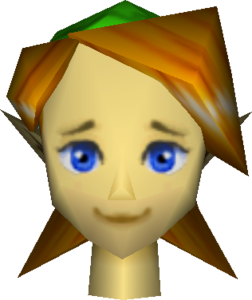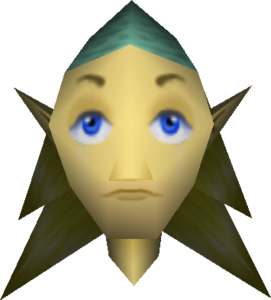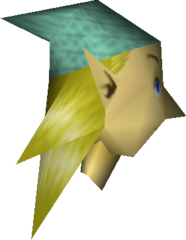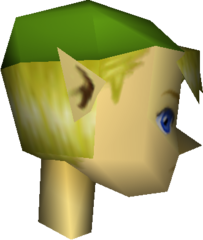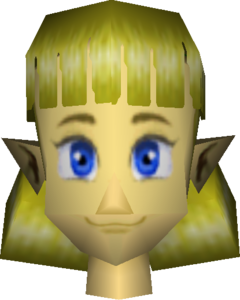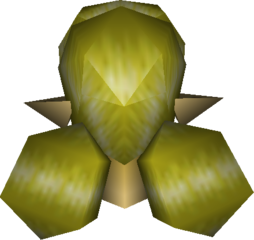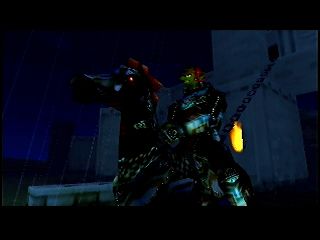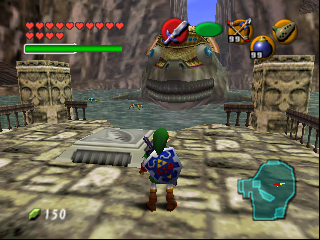The Legend of Zelda: Ocarina of Time/Unused Actors & Objects
This is a sub-page of The Legend of Zelda: Ocarina of Time.
To do:
|
Unused actors and objects in Ocarina of Time. Use Map Select and the codes and info regarding Actor, Object, and Variable Replacement to try loading them yourself.
Contents
- 1 Actors
- 1.1 En_Part
- 1.2 En_Scene_Change
- 1.3 Bg_Pushbox
- 1.4 En_OE2
- 1.5 En_Horse_Zelda
- 1.6 En_Bird
- 1.7 En_Lightbox
- 1.8 En_Pu_box
- 1.9 En_Arow_Trap
- 1.10 En_Vase
- 1.11 Bg_Mori_Hashigo
- 1.12 Item_Shield
- 1.13 Arrow_Fire
- 1.14 Arrow_Ice
- 1.15 Arrow_Light
- 1.16 Obj_Elevator
- 1.17 En_Nwc
- 1.18 Item_Inbox
- 1.19 En_Sda
- 1.20 En_Clear_Tag
- 1.21 En_Go
- 2 Objects
- 2.1 Duplicates
- 2.2 Items
- 2.3 NPCs
- 2.3.1 object_human
- 2.3.2 object_oA1
- 2.3.3 object_oA2
- 2.3.4 object_oA3
- 2.3.5 object_oA4
- 2.3.6 object_oA5
- 2.3.7 object_oA6
- 2.3.8 object_oA7
- 2.3.9 object_oA8
- 2.3.10 object_oA9
- 2.3.11 object_oA10
- 2.3.12 object_oA11
- 2.3.13 object_oB1
- 2.3.14 object_oB2
- 2.3.15 object_oB3
- 2.3.16 object_oB4
- 2.3.17 object_oE1
- 2.3.18 object_oE1s
- 2.3.19 object_oE3
- 2.3.20 object_oE4
- 2.3.21 object_oE4s
- 2.3.22 object_oE5
- 2.3.23 object_oE6
- 2.3.24 object_oE7
- 2.3.25 object_oE8
- 2.3.26 object_oE9
- 2.3.27 object_oE10
- 2.3.28 object_oE11
- 2.3.29 object_oE12
- 2.3.30 object_oF1s
- 2.4 Other
Actors
En_Part
| Actor | Object |
|---|---|
| 0007 | 0001 |
This is an effect spawner for enemies' deaths.
En_Scene_Change
| Actor | Object |
|---|---|
| 0024 | 0040 |
This unused actor has little remaining functionality. All it does is write its name to the console and set a fog parameter. It may have served a similar function to En_Holl, the used actor for the Room Transition Plane that immediately precedes it in the actor list. Why it is connected to object 0040, the used object_jj (Jabu-Jabu), is unclear.
The current source code is 70 lines long, but refers to lines 290 and 386 in its calls to OPEN_DISPS and CLOSE_DISPS, meaning there was likely a lot of code commented out before it was compiled for the final game.
Bg_Pushbox
| Actor | Object |
|---|---|
| 002C | 0003 |
As the name suggests, this is a unused (and non-functional) pushable block. Trying to load this object in-game results in a freeze.
| This needs some investigation. Discuss ideas and findings on the talk page. Specifically: Can this be loaded somehow? |
En_OE2
| Actor | Object |
|---|---|
| 004F | 0035 |
This actor is linked to object_oE2, detailed below. However, when loaded in-game, it only appears as a targetable blue spot. Though she helpfully points it out, Navi has nothing to say about it.
object_oE2
Object 0035 is an early version of the generic red-haired Kokiri girls.
En_Horse_Zelda
| Actor | Object |
|---|---|
| 005B | 0046 |
As you might expect, this actor is linked to object_horse_zelda (Zelda's white horse). However, in the final game, object_horse_zelda is only loaded by En_Viewer, an actor which loads various objects used in cutscenes, so this goes unused.
Link is seen chasing this horse in Hyrule Field in a screenshot from Spaceworld in November 1997.
En_Bird
| Actor | Object |
|---|---|
| 0072 | 0077 |
If loaded using GameShark codes, this unused bird flaps its wings but otherwise remains stationary. It is also missing transparency.
It was later repurposed for Majora's Mask, where several fly around the tree on the plains of the Moon.
object_bird
Object 0077 is present in the object list for Kokiri Forest setup 05, room 01 (Cutscene - The Deku Tree Tells of Ganondorf's Curse), but because it lacks an actor, it's never loaded.
En_Lightbox
| Actor | Object |
|---|---|
| 007C | 0081 |
A large rectangular block that makes a thrumming noise. The sides will light up (aside from the top or bottom) when struck with the sword or Boomerang.
object_lightbox
In addition to the model loaded with the actor above, object 0081 also contains three variants as unreferenced geometry.
| Variant 0x0 | Variant 0x3D0 | Variant 0x7A0 |
|---|---|---|
En_Pu_box
| Actor | Object |
|---|---|
| 007D | 0082 |
This actor appears to behave similarly to the above object_lightbox in that it will light up when struck by the sword or Boomerang, though this is slightly harder to see. Unlike object_lightbox, the top will react to being hit.
object_pu_box
Object 0082 is a small stone cube that has collision data, but cannot be picked up or Z-targeted. If hit with the sword, it sounds like Link is striking metal. Three variants of this block exist within the object as unreferenced geometry.
| Variant 0x0 | Variant 0x700 | Variant 0xA80 |
|---|---|---|
En_Arow_Trap
| Actor | Object |
|---|---|
| 0081 | 0001 |
An unused trap which would periodically spawn an arrow into a fixed direction.
The arrow it spawns does use an unique parameter, which isn't properly set up inside the arrow actor itself, causing it to only become active and changing its intended direction when Link shoots an arrow.
En_Vase
| Actor | Object |
|---|---|
| 0082 | 0086 |
This actor is linked to the unfinished, orange-hued pot below.
object_vase
Object 0086 is a pot whose design is based on the jars in A Link to the Past. Its rim lacks transparency, and it does not have any collision or associated behaviors.
Bg_Mori_Hashigo
| Actor | Object |
|---|---|
| 00E2 | 0072 |
This actor is linked to object_mori_objects, which contains objects used in the Forest Temple. When loaded in-game using variable FFFF, it turns out to be a clasp holding a ladder, which can be shot to make the ladder fall down. The ladder is fully functional and can be climbed. Its filename translates to "Bg_Forest_Ladder".
Item_Shield
| Actor | Object |
|---|---|
| 00EE | 0015 |
This collectable Deku Shield actor is only present in three Kokiri Forest cutscene setups. While it is loaded and visible in-game, one can only view it by using a Walk In Cutscenes code. In addition, because setup 08 and setup 09 aren't used, one must use codes or the Map Select function of the Debug ROM to even view these cutscenes.
| Map | Setup | Room | Setup ID | Used | Quantity |
|---|---|---|---|---|---|
| Kokiri Forest | 07 | 00 | The Deku Tree Speaks With Navi | ✔ | 1 |
| Kokiri Forest | 08 | 01 | Panning Through Kokiri Forest | ✘ | 2 |
| Kokiri Forest | 09 | 01 | Panning Through Kokiri Forest 2 | ✘ | 2 |
Within the cutscenes, the shield exhibits an interesting behavior similar to the Ordon Shield one must knock down in Twilight Princess: When hit with the Slingshot, the shield will jump as though knocked off a wall or shelf, then drop to the ground and remain for a few seconds before flickering and disappearing.
Arrow_Fire
| Actor | Object |
|---|---|
| 010A | 0001 |
| This needs some investigation. Discuss ideas and findings on the talk page. Specifically: What do you do? |
Arrow_Ice
| Actor | Object |
|---|---|
| 010B | 0001 |
| This needs some investigation. Discuss ideas and findings on the talk page. Specifically: What do you do? |
Arrow_Light
| Actor | Object |
|---|---|
| 010C | 0001 |
| This needs some investigation. Discuss ideas and findings on the talk page. Specifically: What do you do? |
Obj_Elevator
| Actor | Object |
|---|---|
| 012B | 011B |
While this actor went unused in the retail version of Ocarina of Time, it is used in Ocarina of Time Master Quest. When loaded in-game and stepped on, it makes a clicking noise as if a switch had been pressed.
object_d_elevator
| To do: Investigate variables. |
Object 011B is a large, 4-tiered stone elevator.
En_Nwc
| Actor | Object |
|---|---|
| 0135 | 0124 |
These primitive-looking baby Cuccos were later revamped and repurposed for use in Majora's Mask.
object_nwc
| To do: Add info about Grog's shop. |
Object 0124 lacks collision, which causes it to fall through the floor and into the void when loaded. The object freeze function in the Debug ROM can be used to prevent this.
Item_Inbox
| Actor | Object |
|---|---|
| 0137 | 0001 |
This actor's name indicates that it is connected to items found in treasure chests.
En_Sda
| Actor | Object |
|---|---|
| 013A | 0001 |
There's a dynamic shadow attribute. It is seen in early screenshots and videos and can be seen in the final game utilized by signs that can be cut. It is also used during the final battles with Ganondorf and Ganon, both on the bosses and the Master Sword, when Ganon knocks it out of Link's hands.
En_Clear_Tag
| Actor | Object |
|---|---|
| 013B | 0001 |
The Arwing from Star Fox 64, used by the developers to model Volvagia's flying animations.
When Link enters a map in which an Arwing is loaded, an animation plays depicting it flying around and doing a barrel roll. It acts as an enemy, firing at Link with its laser beams. It can be vanquished with three Slingshot hits, or the Boomerang. Upon defeat, it will crash and explode in a huge mass of flaming red debris.
Within player_actor there is a routine that spawns an Arwing at coordinates (0,100,0) relative to Link's position. This routine is located after a sequence of code used to determine whether a chest should award an item or freeze Link, suggesting that the Arwing may have once spawned when opening a chest at one point. (Indeed, the Ocarina of Time iQue leak confirms this to be the case.)
En_Go
| Actor | Object |
|---|---|
| 0152 | 00C9 |
While unused, this actor is linked to a used object, object_oF1d_map, which contains the Goron. In the retail game, the used Goron actor is known as En_Go2.
| This needs some investigation. Discuss ideas and findings on the talk page. Specifically: What do you do? |
Objects
Duplicates
object_ny
| Actor | Object |
|---|---|
| [None] | 00E3 |
Oddly, the final game contains two instances of the Spike Trap object: 00E3 and 00E5. Only 00E5 is used. According to the Ocarina of Time iQue leak, object ID 00E3 was originally assigned to "zelda_go2".
| To do: Add info about what zelda_go2 is, and a link. |
object_md
| Actor | Object |
|---|---|
| [None] | 00FA |
Similarly, the final game contains two instances of Mido's object: 00FA and 00FB. Only 00FB is used. According to the Ocarina of Time iQue leak, object ID 00FA was originally assigned to "zelda_gate".
| To do: Add info about what zelda_gate is, and a link. |
Items
The "gi" within some of these filenames indicates the objects were "Get Items", models which Link holds over his head when an item is first obtained.
object_b_heart
Object 0049 is a giant kind of Heart Container that should be used by Item_B_Heart, but does not have any connection despite the name. When spawned, its texture emits an interesting motion effect.
object_gi_melody
Object 00B6 was once displayed when Link learned a new song. It uses variables 0008 to 000C of the used actor 008C, Demo_Kankyo (Cutscene_Environment).
It is present in every cutscene setup where Link learns a melody from Sheik, save for the cutscene where Link learns the Nocturne of Shadow. Despite this, it is never visible in-game.
There is evidence that Demo_Kankyo was used at one point to display this music note. Starting at D45980 in the Debug ROM, there is a list of object dependencies for the different values of Demo_Kankyo's variable. At indexes 08-0C, object 00B6 is listed as a dependency. It's not known if the functionality to display the note still exists. The object has 6 color settings intended for warp songs.
| Map | Setup | Room | Setup ID | Used |
|---|---|---|---|---|
| Ice Cavern | 04 | All | Cutscene - Learning the Serenade of Water | ✔ |
| Shooting Gallery | 05 | 00 | Sasaki Cutscene Test 2 | ✘ |
| Shooting Gallery | 06 | 00 | Sasaki Cutscene Test 3 | ✘ |
| Temple of Time | 00 | All | Normal Gameplay | ✔ |
| Temple of Time | 04 | All | Cutscene - First Time Returning From the Chamber of Sages | ✔ |
| Temple of Time | 06 | All | Cutscene - Learning the Prelude of Light | ✔ |
| Sacred Forest Meadow | 04 | 00 | Cutscene - Learning the Minuet of Forest | ✔ |
| Sacred Forest Meadow | 05 | 00 | Cutscene - Learning Saria's Song | ✔ |
| Desert Colossus | 04 | 00 | Cutscene - Learning the Requiem of Spirit | ✔ |
| Death Mountain Crater | 04 | 01 | Cutscene - Learning the Bolero of Fire | ✔ |
| Death Mountain Crater | 05 | 01 | Cutscene - Learning the Bolero of Fire in Opening Demo | ✔ |
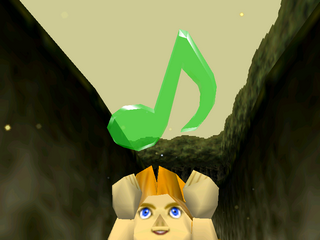
|
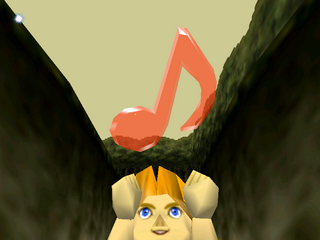
|
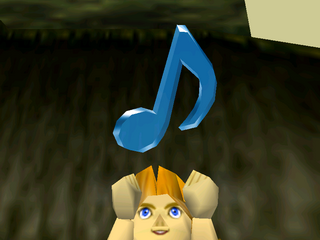
|
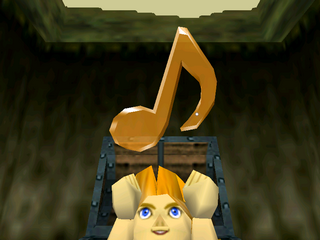
|
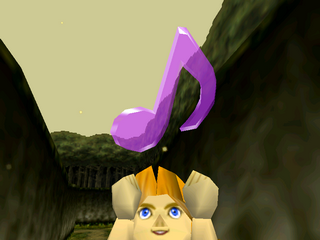
|
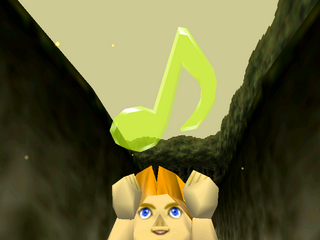
|
object_gi_grass
Object 00F7 is a reed whistle once used by Link for calling Epona, rather than Epona's Song. This idea was revived in the form of the Horse Call item in Twilight Princess.
Link can be seen using this item in pre-release screenshots from April 1998.
object_medal
Object 009F contains early versions of the elemental Medallions, reflecting their original colors. In the final game, the Spirit Medallion is orange, the Shadow Medallion is purple, and the Light Medallion is yellow.

|
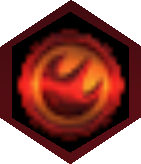
|

|

|

|

|
object_gi_coin
Object 012E contains N-stamped coins in four colors. The colors match that of the Rupees: green, blue, red, and gold. Some of the debug text associated with parameter.c, found in the game's code file, refers to Skulltula tokens as "N Coins".
object_gi_butterfly
Object 0175 is similar to the container that holds the bugs sold in the Potion Shop. (Indeed, the object number of the bottled bug, 0174, immediately precedes it.) A butterfly is visible inside the cage. With a little hacking trickery, the cage can be placed in a shop and purchased, but nothing will appear in Link's inventory.
Because 0068 is missing from the list of purchasable items, and 0067 corresponds to the bottled bug, it's likely that it once corresponded to the butterfly.
object_gi_ocarina_0
Object 010E is a "Get Item" for the Fairy Ocarina, part of a set of models that appear over Link's head when he first obtains an item. However, in the final game, Link receives the Fairy Ocarina from Saria, triggering a unique cutscene in which the camera pans around Link holding the item. As a result, the "Get Item" sequence doesn't occur, and this detailed model is never used.
There is still data in Link's actor, player_actor, that anticipates him obtaining the Fairy Ocarina like a "Get Item". However, the text box displayed upon receiving this ocarina is the "Get" message for the Ocarina of Time.
NPCs
object_human
Object 0006 is an NPC that appeared in pre-release screenshots from 1996-97. She gained the nickname "Aria" through a series of interviews of dubious provenence with a supposed Nintendo insider that originally appeared on the fansite Zeldapower.com.
Her model format is more similar to the NPCs of Super Mario 64 than those in Ocarina of Time. Technical details on this older format can be found here.
object_oA1
Object 0023 is an early version of the Kakariko rooftop man.
object_oA2
| This needs some investigation. Discuss ideas and findings on the talk page. Specifically: Figure out how to load the full model in-game. |
Object 002E is an early version of the Zora. While it is completely untextured, each piece of the model is colored #958DAC, which is a bluish-gray, similar to the skin of a dolphin.
The object is present in the object list of the cutscene in which Link awakens in the Chamber of Sages after seven years of slumber. However, because it lacks a corresponding actor, it is never loaded.
Debug text found in actor En_Xc suggests that its filename originally belonged to Sheik.
object_oA3
Object 003B is an early version of Impa's masked head. It can be seen in pre-release screenshots of the cutscene in which Zelda and Impa flee from Hyrule Castle.
object_oA4
Object 003C is a Hylian man in a blue shirt and white pants. He can be seen in a pre-release screenshot of the Market from November 1997.
object_oA5
Object 003D is a thin Hylian woman in a purple dress. A similar, more refined version of this model is used in the Market. She can be seen in a pre-release screenshot of the Back Alley.
object_oA6
Object 003E is a Hylian man in a blue shirt and orange pants. This object was accidentally given two left arms, causing the view from the right side to look unusual. However, the right arm still exists as unreferenced geometry in the model at offsets 1028 and 10B8, making it possible for the model to be restored.
| Original | Restored |
|---|---|
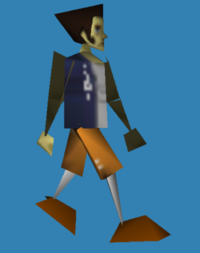 |
 |
object_oA7
Object 003F is a Hylian woman in a white shirt and orange pants. She can be seen in a pre-release screenshot of the Market from November 1997.
object_oA8
Object 0041 is an old Hylian man.
object_oA9
Object 0042 is the hooded head of an old Hylian man.
object_oA10
Object 0057 is an early version of a Hylian soldier. It is present in the object lists of the Castle Hedge Maze (Day) and Castle Hedge Maze (Night) maps, but it's never loaded because it lacks a corresponding actor.
object_oA11
Object 0058 is another early version of a Hylian soldier. It can be seen in a pre-release screenshot from June 1998.
object_oB1
Object 0028 is an early version of the Bazaar proprietor.
object_oB2
| This needs some investigation. Discuss ideas and findings on the talk page. Specifically: Render this properly... |
Object 0043 is a bearded Hylian man in a purple shirt and green pants.
object_oB3
Object 0044 is an early version of the carpenter boss' wife.
object_oB4
Object 0045 is a Hylian woman wearing a blue smock and a white dress. She appears in Kakariko Village in this 1998 pre-release trailer.
A similar, more refined version of this model is used in the Market.
object_oE1
Object 0033 is an early version of Mido.
object_oE1s
| This page or section needs more images. There's a whole lotta words here, but not enough pictures. Please fix this. |
Object 00C3 is another early version of Mido. Appears identical to other, though this one comes with a single "animation" built in, that being a static pose with his arms by his sides.
object_oE3
Object 004B is an early version of Saria. The unused animation file object_oE_anime contains an early animation for her, which she is seen performing in this pre-release screenshot from November 1997.
| Pre-release Screenshot | Restored Object |
|---|---|
 |
object_oE4
Object 004C is an early version of the generic red-haired Kokiri boys.
object_oE4s
Object 00C4 is another early version of the generic red-haired Kokiri boys.
| This page or section needs more images. There's a whole lotta words here, but not enough pictures. Please fix this. |
object_oE5
Object 004E is an unused female Kokiri NPC. At one point, the Kokiri characters had more varied designs. This particular girl appears in pre-release screenshots from November 1997. She has blonde hair, and her vest features dual Kokiri symbols. This object is dependent upon object_oE2, which contains geometry that object_oE5 needs in order to be loaded properly.
Because of this NPC's blonde hair, she is often mistaken for an early version of Fado.
object_oE6
Object 004F is the head of a blonde Kokiri girl wearing a brown band. This model was used in the Spaceworld '97 demo.
| Front | Side | Back |
|---|---|---|
object_oE7
Object 0050 is the head of an open-mouthed Kokiri boy wearing a green cap. This model was used in the Spaceworld '97 demo.
| Front | Side | Back |
|---|---|---|
object_oE8
Object 0051 is the head of a red-haired Kokiri girl wearing a green band. This model was used in the Spaceworld '97 demo.
| Front | Side | Back |
|---|---|---|
object_oE9
Object 0052 is the head of a blonde Kokiri boy wearing a mint-colored cap. This model was used in the Spaceworld '97 demo.
| Front | Side | Back |
|---|---|---|
object_oE10
Object 0053 is an early version of the Kokiri Shop proprietor's head. This model was used in the Spaceworld '97 demo.
object_oE11
Object 0054 is the head of a blonde Kokiri boy wearing a small green beanie. This model was used in the Spaceworld '97 demo.
| Front | Side | Back |
|---|---|---|
object_oE12
Object 0055 is an early version of Fado's head. This model was used in the Spaceworld '97 demo.
| Front | Side | Back |
|---|---|---|
object_oF1s
Object 00CF is an early version of the Goron. This object contains unreferenced geometry at offset 84E0 displaying an early Goron curl. This curl is recorded as static geometry instead of the animated position used in the final, and has a head that appears less tucked.
| Early Goron Curl | Final Goron Curl |
|---|---|
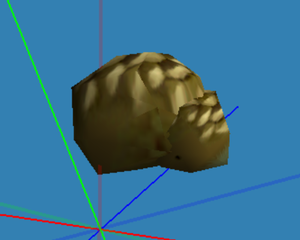 |
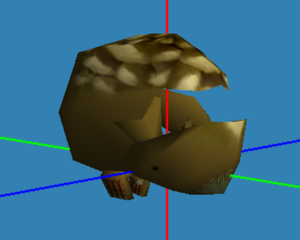 |
Other
object_fire
Object 000F is an early flame animation with eight frames. This was originally used for the torches alongside the drawbridge at Hyrule Castle.
The fire effect used in the final game consists of two overlapping textures: a flame shape and a noise image. The noise image scrolls to create the illusion of flickering. This is less resource-intensive, and uses a longer animation loop.
object_mjin_oka
Object 0068 is a song pedestal with an ocarina design. The appearance of the ocarina reflects an earlier stage of development when it would have been inlaid with the three Spiritual Stones.
This pedestal is present in several cutscene setups:
| Map | Setup | Room | Setup ID | Used |
|---|---|---|---|---|
| Kokiri Forest | 08 | 00 | Panning Through Kokiri Forest | ✘ |
| Kokiri Forest | 09 | 00 | Panning Through Kokiri Forest 2 | ✘ |
| Kokiri Forest | 07 | 01 | The Deku Tree Speaks With Navi | ✔ |
| Kokiri Forest | 08 | 01 | Panning Through Kokiri Forest | ✘ |
| Kokiri Forest | 09 | 01 | Panning Through Kokiri Forest 2 | ✘ |
| Sacred Forest Meadow | 04 | 00 | Learning the Minuet of Forest | ✔ |
| Sacred Forest Meadow | 05 | 00 | Learning Saria's Song | ✔ |
| Zora's Fountain | 04 | 00 | Receiving Zora's Sapphire | ✔ |
| Zora's Fountain | 05 | 00 | Jabu-Jabu Inhales | ✘ |
| Zora's Fountain | 06 | 00 | Credits in Zora's Fountain | ✘ |
| Desert Colossus | 04 | 00 | Learning the Requiem of Spirit | ✔ |
| Ganon's Castle Exterior | 04 | 00 | Sages Construct the Rainbow Bridge | ✔ |
However, it is only loaded and visible during gameplay in setups 05 and 06 of Zora's Fountain.
A contemporary fan account of playing the 1998 CBS Toy Test demo suggests that these pedestals were once used as song triggers, forcing Link to take out his Ocarina and displaying a musical staff when stepped on.
